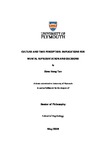Culture and Time Perception: Implications for Mental Representation and Decisions
| dc.contributor.supervisor | Hollins, Tim | |
| dc.contributor.author | Tan, Siew Hong | |
| dc.contributor.other | School of Psychology | en_US |
| dc.date.accessioned | 2018-11-19T17:36:38Z | |
| dc.date.available | 2018-11-19T17:36:38Z | |
| dc.date.issued | 2018 | |
| dc.identifier | 10302033 | en_US |
| dc.identifier.uri | http://hdl.handle.net/10026.1/12834 | |
| dc.description.abstract |
This thesis examines cultural variations in time perception, as well as the possible influences on mental representation and decisions. Building on prior research on cultural differences in time-related perceptions, two main time perceptions were identified and focused on, namely temporal orientation and the use of time metaphor. The temporal orientation line of investigation explores the implications of a stronger future versus past orientation among English and Mandarin-speakers respectively. Based on Construal Level Theory, temporal orientation is expected to be related to psychological distance, which in turn affects the mental representations individuals form. The findings supported a stronger future orientation among English-speakers which is also evident in their mental representations that vary as a function of temporal orientation. However, Mandarin-speakers exhibited neither a strong past nor future orientation. A study examining the possible influence of temporal orientation on value judgment revealed a complex association between culture and value judgment. The time metaphor line of inquiry investigates the use of time metaphors among English and Mandarin-speakers and also the possible implications of such tendencies. Although previous psychological research implies a possible connection between the use of time metaphor and sense of personal control, this relationship is yet to be established. The findings showed supportive evidence of a frequent use of ego and time-moving metaphors among English and Mandarin-speakers respectively. However, studies examining the relationship between the use of time metaphor, perceived personal control, and decisions (optimism bias and risk-taking) revealed little supportive evidence of an association between them. The findings and a range of methodological and theoretical implications are discussed in the closing chapter. | en_US |
| dc.language.iso | en | |
| dc.publisher | University of Plymouth | |
| dc.subject | Culture | en_US |
| dc.subject | Time Perception | |
| dc.subject | Mental Representation | |
| dc.subject | Judgment and decision | |
| dc.subject.classification | PhD | en_US |
| dc.title | Culture and Time Perception: Implications for Mental Representation and Decisions | en_US |
| dc.type | Thesis | |
| plymouth.version | publishable | en_US |
| dc.identifier.doi | http://dx.doi.org/10.24382/390 | |
| dc.identifier.doi | http://dx.doi.org/10.24382/390 | |
| dc.rights.embargoperiod | No embargo | en_US |
| dc.type.qualification | Doctorate | en_US |
| rioxxterms.version | NA |
Files in this item
This item appears in the following Collection(s)
-
01 Research Theses Main Collection
Research Theses Main


